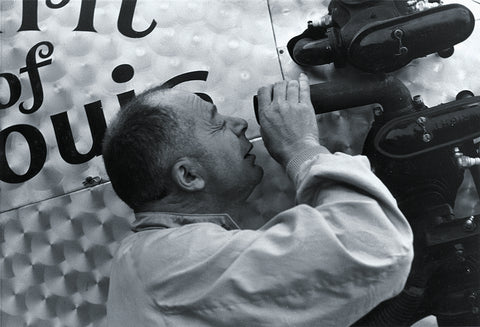
Why Did Billy Wilder Call ‘The Spirit of St. Louis’ His Worst Movie?
Designers Charles and Ray Eames are known for the modernistic chair that bears their names, but the married couple were also close friends with film director Billy Wilder (whose credits included Some Like It Hot and Sunset Boulevard ). In 1955 Wilder asked Charles to join him as a photographic consultant on his latest project. The film was The Spirit of St. Louis , Wilder’s adaptation of Charles Lindbergh’s 1953 book about his life and his famous solo hop across the Atlantic in 1927. Eames shot candid photos of the film’s production, images that have rarely if ever been published until now.
The Jewish Wilder was eager to take on the film, despite Lindbergh’s troubling isolationist and arguably anti-Semitic politics in the years leading up to World War II. When Wilder and Lindbergh flew to Washington to see the original Spirit at the Smithsonian Institution prior to filming, their flight hit turbulence. The puckish Wilder leaned over to Lindbergh and said, “Mr. Lindbergh, would it not be embarrassing if we crashed and the headlines said, ‘Lone Eagle and Jewish Friend in Plane Crash’?” Even more troubling for Wilder than Lindbergh’s past was the director’s inability to penetrate the aviator’s character. “There was a wall there,” he said.
To play the Lone Eagle, Wilder hired James Stewart. It was perfect casting—or it would have been, had Wilder made the film 20 years earlier. The real Lindbergh was only 25 when he made his flight; at the start of the shoot Stewart was more than two decades older.
The production was troubled and Wilder lost interest before shooting ended in 1957, with director John Sturges stepping in for an uncredited role shooting some final scenes. The film failed at the box office when released later that year and Wilder himself remained disappointed by what he once called his worst film. Still, director Cameron Crowe, who published a book of his conversations with Wilder, felt differently. “Wilder’s much underrated color portrait of Lindbergh’s famous journey is a sumptuous biopic,” he wrote. Charles Eames’ photographs provide a fascinating look behind the scenes.
Photos © Eames Office, LLC. All rights reserved
In The Spirit of St. Louis, director Billy
Wilder and screenwriter Wendell Mayes fleshed out the story of Charles
Lindbergh’s New York-to-Paris flight with flashbacks of Lindbergh’s aviation
career. Here the film crew shoots a barnstorming sequence.
Designer Charles Eames was a friend of
Wilder’s and worked on the production as a photographer.
Here director Wilder seems to be mistaking an
exhaust on one of the movie’s Spirit of St. Louis replicas for a camera’s
viewfinder
The movie built two flying versions of the
Spirit of St. Louis as well as this static model for scenes on the ground. One
of the flying replicas is now on display at the Henry Ford museum in Dearborn,
Michigan, and the other is at the Missouri History Museum in St. Louis. The
static model used to hang in the Minneapolis-St. Paul Airport and is now owned
by Wings of the North in Eden Prairie, Minnesota.
Actor James Stewart was a pilot himself and
flew 20 combat missions in B-24s during World War II. He considered the part
of Lindbergh the role of a lifetime. Here he sits in the cockpit of a de
Havilland DH-4 that was used for a flashback airmail sequence.
Stewart hangs from a parachute in the studio
as he depicts Lindbergh’s descent from his airmail plane. When finishing the
scene on location, the wind caught Stewart’s parachute and dragged him 50 feet
across the ground.
The crew shoots another barnstorming sequence
with a Curtiss Jenny.
A scene with a Pathé News crew and their
airplane did not make it into the final film.
Studio crew prepare to position some stunt
trees while actor Murray Hamilton waits for his cue at the wing of a Jenny.
Hamilton, later known as the mayor in the movie Jaws, played Lindbergh’s real-
life friend and fellow barnstormer, Harlan “Bud” Gurney. The character
appeared in only one scene in the movie, in which he and Lindbergh talked
about their mutual love of flying. The real Gurney, who ended his flying
career in 1965 as a pilot for United Airlines, served as a technical advisor
on the movie.
The Warner Bros. crew applies some last-
minute makeup to actor Hamilton. While much of the film was shot on sets, some
of the movie was filmed on location, mostly in California. The scene of
Lindbergh’s arrival at Le Bourget Airport, though, was filmed in France,
although at a different airport near Versailles.
Wilder, seated on the fence, converses with
some of his crew between setups. At one point during the shoot star James
Stewart bet Wilder he wouldn’t dare attempt wing walking. Wilder had himself
strapped to the top wing of a biplane and won the bet, donating his winnings
to charity.
The Spirit of St. Louis became almost a
character in the movie itself. Lindbergh spent more than 33 hours alone in the
airplane’s cramped cockpit on his transatlantic flight, and dramatizing that
proved challenging when writing the screenplay. One solution was to have
Lindbergh talk to a fly that took refuge in the airplane. “Mr. Stewart did not
object to talking to insects,” said Wilder. “After all, he had to deal all of
his life with agents and producers.”
The scene of Lindbergh’s takeoff from
Roosevelt Field in New York was actually filmed at Santa Maria, California.
this article first appeared in AVIATION HISTORY magazine
Facebook @AviationHistory | Twitter @AviationHistMag
